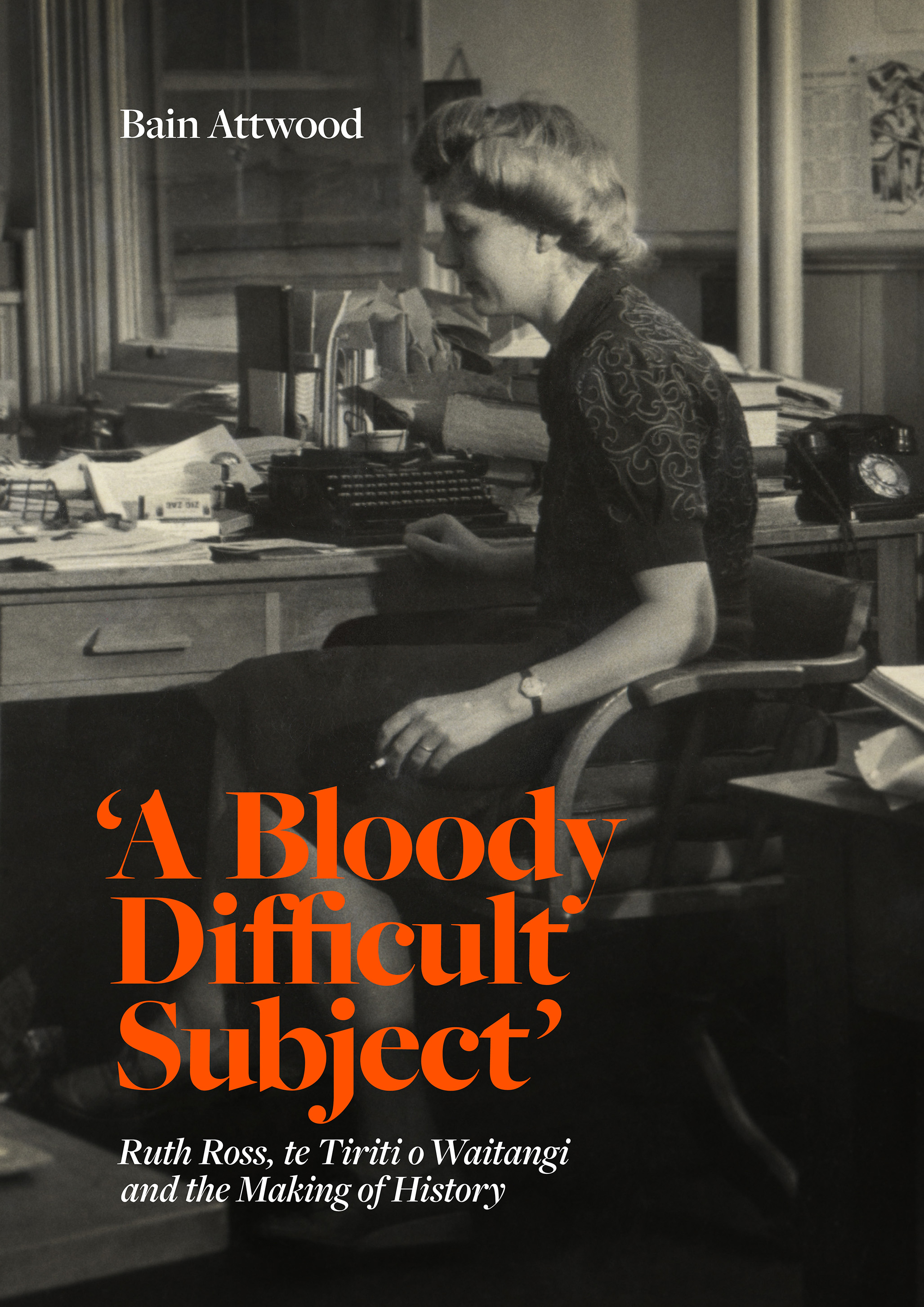A Bloody Difficult Subject: Ruth Ross, te Tiriti o Waitangi and the Making of History
A Bloody Difficult Subject: Ruth Ross, te Tiriti o Waitangi and the Making of History by Bain Attwood. AUP (2023). RRP: $59.99. HB, 320 pp. ISBN: 9781869409821. Reviewed by Vaughan Rapatahana (Te Ātiawa)
Te Tiriti o Waitangi: a bloody difficult subject? It seems yes, according to Bain Attwood and his historical muse, Ruth Ross.
After an intriguing and invigorating first part where Ross (nee Guscott) is discussed at length, including her somewhat intractable yet also fragile personality, her domestic status, her employment vicissitudes, her movements to wāhi such as Motukiore, and her dealings with folk like James K. Baxter, the text rather seismically shifts away from her.
The longer two later sections of A Bloody Difficult Subject, Ruth Ross, te Tiriti o Waitangi and the Making of History become as the subtitle implies, more of a catalogue, or a veritable litany of this country’s historians—both academic or ‘cloistered’ and popular or ‘public’, living, and deceased—such as Beaglehole, Belgrave, Binney, Orange, Sinclair, Ward, Wards, et al. Indeed, the text becomes progressively somewhat turgid and technical, where Ross is swamped by a slew of statements as to what Te Tiriti o Waitangi both was intended to be and received as, and what it has come to mean or could mean today. As well as a lengthy exegesis as to what History is or could/should be and what its relationship to Te Tiriti has been and yet could be.
Latterly, then, Ross tends to disappear as do her two key edicts from her ‘famous’ 1972 essay titled Te Tiriti o Waitangi Texts and Translations, published in the New Zealand Journal of History, October 1972. Accordingly, I am much more interested in reading about Ross and am slightly disappointed that her pioneering whakaaro about Te Tiriti becomes rather subsumed by historiographical philosophies.
What did Ross say in 1972, remembering also that her thoughts had been solidifying during the 1950s? Her key statements were:
“The fact that the Treaty of Waitangi was an agreement in the Maori language is consistently ignored…In the present century, most discussion ignores the fact that the Treaty of Waitangi was an agreement in the Maori [sic] language.” (p 129)
“It is a symbol, of Pakeha self-righteousness, of Maori [sic] disillusionment. On the one hand, lip service is paid to its ‘spirit’ and ‘intentions’; on the other, agitation mounts for its ‘observance’ and ‘ratification.” (p 154)
“A close study of events shows that Te Tiriti was hastily and inexpertly drawn up, ambiguous and contradictory in content, chaotic in its execution.” (p 154)
Attwood credits Ross with two main ‘claims’, if that is the correct term, which are not necessarily independent of each other. Firstly, her historical, well-researched facts of the matter show unequivocally that the founding and formation of the Treaty of Waitangi was a discordant and hasty mess. A floundering formulation overall, which was a long way adrift from a fair and balanced Magna Carta for the nascent Dominion.
Ross’ invocation of Te Tiriti terms that were supposedly translated from and later back into te reo Ingarihi such as kawanatanga, rangatiratanga, taonga, and their potential meanings in 1840—and before, if the 1835 ‘Declaration of Independence’ is also invoked—further muddies the boil-up that was Te Tiriti. She also emphasises that there was no mention of a key term, namely mana. Thus, “in the Treaty of Waitangi there is no mention at all of mana,” and she is suspicious as to why this was so, “It is difficult not to conclude that the omission of mana from the text of the Treaty of Waitangi was no accidental oversight” on the part of the drafters. What then was comprehended as ‘sovereignty’ in those years, by both parties?
Secondly, her groundbreaking statement—at least for Pākehā then—that Te Tiriti o Waitangi was and is the version written in te reo Māori as signed by several Māori, and concomitantly, Ross’ implication that it is Māori interests that should be upheld, even given the veracity of the first point made. Ironically, Attwood attests to the fact that, “this was not the main point Ross was trying to make about it [Te Tiriti]”.
While her first claim strikes me as cogent and correct, and given that Attwood claims that there was still sufficient mutually concordant impetus and at least some common ground before, since and in 1840, between Pākehā politicians and clergymen, and disparate Māori ariki as to circumscribe such vagueness and variance, it is her second edict that has garnered more acclaim and response. No one on the Pākehā side of the platter was saying what Ross manifestly believed as the 1950s wore on and what she wrote in 1972. Yet, as Attwood declares, she would have been “dumbfounded” that her supposedly ‘minor’ claim became the prime point of focus of her paper.
Therefore, for me, Ruth Ross is a Pākehā heroine as she had the foresight and courage to go against the twin braids of both the anti-female, and the anti-the possibility of Māori having a voice panopticon – back then in the male Pākehā-dominated 1950s. Her pioneering aspect is the key to this well-researched book. Ross was a veritable Pākehā-Māori of the 20th century, a concept so well-delineated by Trevor Bentley in his own pantheon.
Later in his tome, in the second and third sections, Attwood does strive for sense with his somewhat treacly explanations and quotations including some from several non-Kiwi overseas historians and theoreticians in relation to modern-day interpretations of Te Tiriti o Waitangi. In places, however, meaning seems almost as muddled and as open to misinterpretation as Te Tiriti itself.
All the more reason to maintain the primacy of te reo Māori Te Tiriti o Waitangi. It is this Māori language compact that we all live with in Aotearoa, and it is this we all need to accept, even if it has been reinterpreted over time. That is, what Te Tiriti has come to mean and be (legally) prescribed for Aotearoa New Zealand nowadays, both during and after the canonical years of the Waitangi Tribunal from its establishment in 1975.
In a recent interview with the New Zealand Herald, Attwood articulates this more clearly, “What’s happened since the mid-1980s, is that the law in my view has now become the dominant idiom”, and he attributes this ‘paradigm shift’ to legalese as influencing any historian’s work since on Te Tiriti.
Significantly for me, is the point that although Attwood does accept the historical injustices meted out to Māori ever since 1840 whereby any apposite interpretation of Te Tiriti was often rampantly ignored, he never goes near specifying them and thus we lose sight of the visceral historical realities of what interventions were imposed on Māori—such as Rangiaowhia (although he stresses that Ruth Ross was affected when first learning about that massacre), Ōrakau, Tātaraimaka, up until more contemporary inequities such as Bastion Point, because we are somewhat swamped by the flood of his cascading terminologies. There is some likelihood then, that many readers will find valence in the following kupu, as once reported by the star of this book, Ruth Miriam Ross, namely, “Our sayings will sink to the bottom like a stone, but the words of the Pakeha [sic] will float, like the wood of the whau tree, and always remain to be seen,” (Mohi Tāwhai, 1840).
Moreover, Attwood does not mention any contemporary Maōri historians such as Monty Soutar and Danny Keenan, the latter of whose comments in his recent volume Wars Without End could surely have been empathised with and emphasised, in the concluding stages where Attwood itemises his various tenets of the discipline. States Keenan, “It was once said that ‘all history is argument’. It is an argument between different historians, different methods, between past and present, even between what actually happened, and what happens next”. Tika tēnei kōrero.
Despite my reservations about the abstruseness and the lack of diaphaneity in the latter part of this book, most especially in the final chapter, Attwood has gifted us new material to reflect on as we traverse in our individual and societal understandings of what Te Tiriti o Waitangi is and should be, for all residents of an increasingly multicultural Aotearoa. Always recalling that it was Te Tiriti o Waitangi that was attested to in 1840, not the Treaty of Waitangi. And that interpretation itself is an ongoing evolving process, as firmly evinced by The Waitangi Tribunal during the Eddie Durie years: “the spirit of the Treaty transcends the sum total of its component parts and puts narrow and limited interpretations out of place.” This is the bedrock. Ko he whakataukī rongonui nē rā, ‘Ka mua, ka muri’.
As such then, Te Tiriti o Waitangi is perhaps not such a ‘bloody difficult subject’, after all, whatever contemporary historians maintain. In saying this, the splendid mahi of Ruth Ross should not be abnegated, but seen as a vital underlying causative component in this summation. Tēnā koe anō a Ruth.
Vaughan Rapatahana commutes between Hong Kong SAR, Philippines and Aotearoa New Zealand. He is widely published across several genres in Māori and English and his work has been translated into Bahasa Malaysia, Italian, French, Mandarin. He participated in World Poetry Recital Night, Kuala Lumpur, September 2019, and Poetry International, the Southbank Centre, London in October 2019 – in the launch of Poems from the Edge of Extinction and in Incendiary Art: the power of disruptive poetry. Vaughan’s poem ‘tahi kupu anake’ is included in the presentation by Tove Skutnabb-Kangas to United Nations Forum on Minority Issues in Geneva in November 2019.

